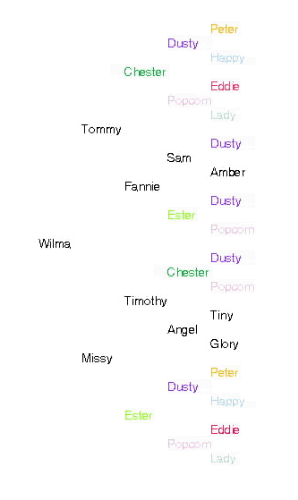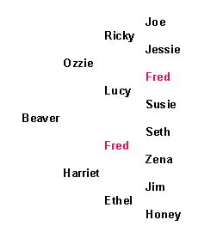

One of the most hotly talked about topics with regard to pure-bred dogs is the use of in-breeding. This is a term that is often misused and is extremely misunderstood.
Part of the misunderstandings come from differences in the way the terms are used within the scientific/medical field, and how it is commonly used by breeders. These are the most commonly accepted definitions used by serious dog breeders and will be the definitions used within this article.
In-breeding - This is the breeding of closely related animals. Brother-Sister, Parent-Offspring, ½ brother - ½ Sister.
Line-breeding - This is the breeding of animals that share common ancestors but are not closely related. For example the dogs may share a common great-grandparent.
Out-cross - This is generally considered the breeding of animals with no common ancestors within the first 4 or 5 generations.
In-breeding causes genetic diseases - Breeding closely related animals increases the possibility that any bad genes in a line will show up. It does not 'cause' genetic disease.
Out-crossed dogs are healthier - This is only partly true. There is a known phenomenon called Hybrid Vigor. Two animals of unrelated strains breed and the offspring is often bigger and grows faster than it's purebred cousins. This method is often used by farmers in order to get their animals to market sooner. But one of the biggest misconceptions of hybrid vigor is that it applies to all animals of mixed heritage. Hybrid Vigor only applies to the animals that are the direct offspring of the crossing of the unrelated strains. In other words if you continue to breed animals of different strains there generally will not be any additional increase in hybrid vigor. If the unrelated strains share common genes for genetic disorders, hybrid vigor will not over ride the risk of the disorder showing up. Out-crossing can also cause problems if widely divergent physical types are mixed due to differences in growth rates and bone and muscle sizes.
By definition, purebred dogs have a smaller gene pool to draw on than mixed breed dogs. That smaller gene pool gives the breed its individual characteristics, such as physical appearance and temperament. It is what makes a poodle a Poodle and a Golden Retriever a Golden Retriever. But there is considerable controversy with regard to whether the gene pools of the modern pure-bred have become too small.
Inbreeding -
In-breeding is more likely to help "set" or "fix" a particular trait within a breed or a line by narrowing the gene pool to favor those traits. So if a breeder is looking to set a particular desirable feature of their line then in-breeding and choosing the offspring most strongly possessing that trait can be beneficial.
Here are samples of an in-bred pedigrees -
|
|
|
 |
 |
In-breeding can also help identify those bad genes that exist within a line. Dogs possessing the bad genes can be eliminated from a breeding program and carriers also identified.
Intermittent in-breeding within a line or breed is not damaging to the long term health of the animals. However, in-breeding over successive generations can lead to reduced fitness and fertility problems among the offspring, resulting in a phenomena known as In-breeding Depression. It can take many generations to show up depending on the traits involved.
To use this method responsibly a breeder would not want to in-breed on animals with known genetic disorders, temperaments not in keeping with it's given breed, or known serious structural faults, or to in-breed frequently even on healthy-superior specimens.
Line-Breeding -
Line-breeding is another way to help "set" or "fix" desirable traits. With line-breeding you breed animals that are related, but you are also routinely introducing genes from other lines into the genetic mix. It takes longer to fix the desirable traits this way, but doing so lowers the risk of those problems associated with repeated in-breeding. With a tight line-breeding you might find the same 3, 4 or more dogs showing up numerous times in a 5 generation pedigree.
Here's an example of a tightly line-bred pedigree (I've identified those dogs whose names show up more than once by color)

Loose line-breeding over successive generations will result in more variations of physical appearance than would in-breeding or tight line-breeding, but will keep the physical look and structure within the same general size and shape, it also carries fewer long term risks.
And a sample of loose line-breeding (as with the above pedigree I'll identify dogs whose names repeat by color):

According to geneticists. Line-breeding can be carried on for many many generations without deleterious effects on the line or breed as long as the individuals involved have few hidden genetic disorders.
Out-Crossing -
Out-crossing in terms of pure-bred dogs is the breeding of unrelated dogs. On a pedigree no names will be repeated within the first 5 generations.
This type of breeding has both advantages and disadvantages. Which as it turns out are flip sides of the same argument. With out-crossing you are maintaining the greatest genetic diversity, but this also leads to the least consistency in terms of physical appearance and other traits.
Out-crossing does not guarantee that the animals won't develop genetic disorders, but it does tend to reduce the numbers of affected offspring. Your best chance of getting an animal that is less prone to developing a genetic disorder comes more from finding a conscientious breeder that screens their animals for hereditary disorders and breeds for the betterment of the breed.
All three methods of breeding have their place in a long term, well thought out breeding program. Talk to the breeder, ask questions as to what their goal is in doing a particular breeding. Ask about the risks and what problems are known to that line. And all lines have some because the perfect dog and the perfect lines are still goals of the future for all breeders.
All material contained on this website is copyrighted and the property of the website administrator/owner. Unauthorized use without express written permission of the authors or owners is forbidden.
For any questions about this website contact